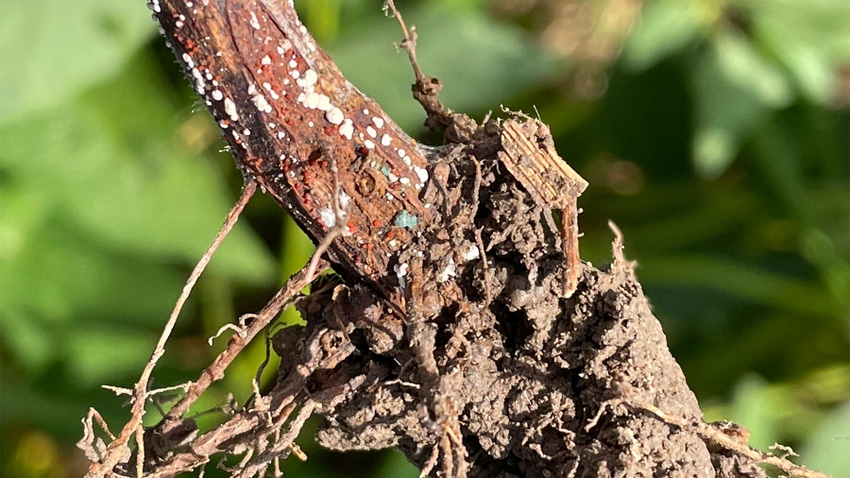
Chad Threewits saw red crown rot in soybeans for the first time in 2023. Threewits, an agronomist for Syngenta who covers most of Indiana, isn’t sounding alarm bells yet, but he encourages growers to learn about the disease.
“We want people to be aware that this disease is moving slowly into the Corn Belt,” he explains. “Symptoms resemble other diseases, particularly sudden death syndrome. But it can extract a bigger yield hit than SDS.”
Threewits imparted some basic information during this exclusive interview:
Is this a new disease? No. It was reported in Illinois in 2018 and was in Kentucky last year. Now it’s in Indiana. It was likely in Indiana last year. Unless you look closely, it can be confused with SDS.
How widespread is it? Our sources say it has been in southern Illinois for a while. In most areas, it’s scattered instead of being intense. It can also be scattered even within a field.
What are the symptoms? Yellow flecking on leaves appears in August or later, followed by interveinal chlorosis. These areas become necrotic, and the plant dies.
That sounds like SDS. How are the two diseases different? Symptoms start out similarly, but SDS doesn��’t usually kill plants. That’s why if red crown rot hits a field, it can impact yield harder than SDS might. Both are caused by fungi, and both overwinter in the soil. Both are also loosely connected with soybean cyst nematode. Feeding by nematodes on roots opens sites for infection.
Both infect seedlings early in the season. However, SDS likes cool, wet weather, while red crown rot thrives in warm, wet weather. Some agronomists suggest delaying planting for SDS while urge planting earlier if you know red crown rot is in the field.
How do you know you have red crown rot? What sets it apart from SDS is red discoloration on the stem at the soil line. Stems on plants with SDS will be tan or brown. So, if you see foliar symptoms, check stems at the soil line. To be sure it’s red crown rot, send samples to your university lab. We know we found red crown rot in eastern Indiana because it was confirmed by a lab.
What can you do about red crown rot? Collectively, we’re still in the learning phase. If you have it, consider rotating that field out of soybeans for a couple of years. Second, control cyst nematodes. You can also use a seed treatment if you have it. Syngenta offers Saltro fungicide seed treatment, effective against SDS and cyst nematode. Saltro also received a 2(ee) label in ’24 for suppression of red crown rot in Arkansas, Illinois, Indiana, Iowa, Kentucky, Missouri and Tennessee.
What if you haven’t seen it yet? Be aware that it could be in your area. If you see symptoms next summer, don’t assume it is SDS. Check stems for red discoloration at the soil line. Consider sending samples to a lab for identification. Follow what we learn at syngentaus.com.
About the Author(s)
You May Also Like




